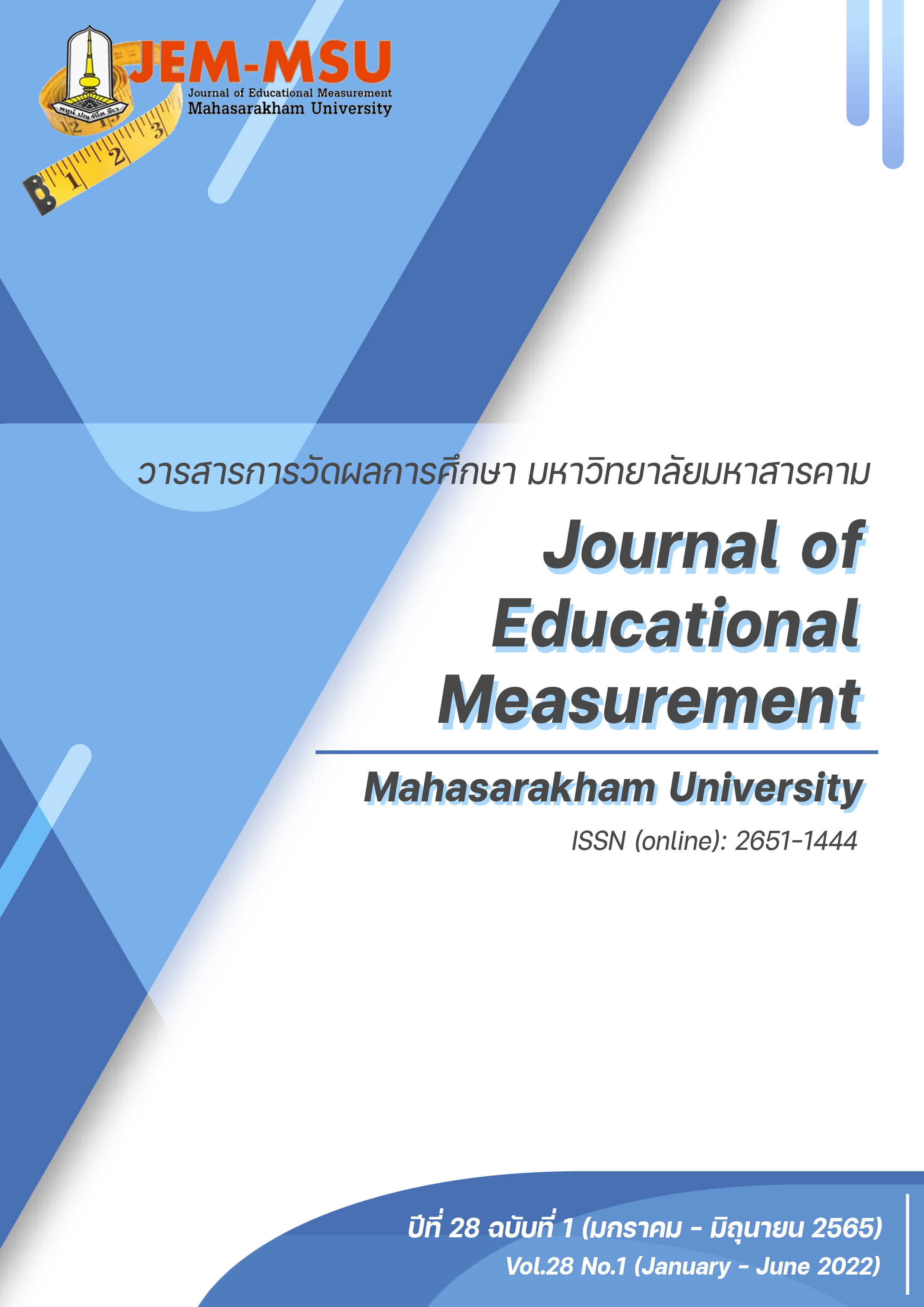การพัฒนาระบบสร้างข้อสอบอัตโนมัติสำหรับจัดคลังข้อสอบจำแนกตามเนื้อหาและระดับความยาก: การประยุกต์แนวคิดวิศวกรรมการประเมิน
Main Article Content
บทคัดย่อ
การวิจัยครั้งนี้มีวัตถุประสงค์เพื่อ 1) สร้างโมเดลข้อสอบวิชาคณิตศาสตร์ ชั้นมัธยมศึกษาปีที่ 1 และ 2) พัฒนาระบบสร้างข้อสอบอัตโนมัติสำหรับจัดคลังข้อสอบจำแนกตามเนื้อหาและระดับความยาก วิชาคณิตศาสตร์ ชั้นมัธยมศึกษาปีที่ 1 วิธีการดำเนินการวิจัยแบ่งเป็น 2 ระยะ คือ 1) การสร้างโมเดลข้อสอบวิชาคณิตศาสตร์ ชั้นมัธยมศึกษาปีที่ 1 และ 2) การพัฒนาระบบสร้างข้อสอบอัตโนมัติสำหรับจัดคลังข้อสอบจำแนกตามเนื้อหาและระดับความยาก วิชาคณิตศาสตร์ ชั้นมัธยมศึกษาปีที่ 1
ผลการวิจัยพบว่า
1. การสร้างโมเดลข้อสอบวิชาคณิตศาสตร์ ชั้นมัธยมศึกษาปีที่ 1 ประกอบด้วยส่วนสำคัญ 5 ส่วน ได้แก่ 1) โจทย์ 2) ส่วนประกอบ 3) ตัวเลือก 4) ข้อมูลเสริม และ 5) เฉลย ข้อสอบที่เหมาะสมในการสร้างเป็นโมเดลข้อสอบจำนวนทั้งหมด 203 ข้อ และสร้างเป็นโมเดลข้อสอบจำนวน 10 รูปแบบ โดยรวมโมเดลข้อสอบ มีความถูกต้องผ่านเกณฑ์
2. ระบบสร้างข้อสอบอัตโนมัติสำหรับจัดคลังข้อสอบจำแนกตามเนื้อหาและระดับความยาก วิชาคณิตศาสตร์ ชั้นมัธยมศึกษาปีที่ 1 ที่พัฒนาขึ้นในรูปแบบของเว็บแอปพลิเคชัน สามารถใช้งานผ่านระบบอินเทอร์เน็ตได้ที่ https://www.aig-system.com โปรแกรมในภาพรวมมีความเหมาะสมอยู่ในระดับมาก เป็นที่ยอมรับของผู้เชี่ยวชาญ และการประเมินประสิทธิภาพในการใช้งานของโปรแกรมอยู่ในระดับดีมากเป็นที่พึงพอใจของผู้ทดลองใช้โปรแกรม
Article Details

อนุญาตภายใต้เงื่อนไข Creative Commons Attribution-NonCommercial-NoDerivatives 4.0 International License.
เนื้อหาและข้อมูลในบทความที่ลงตีพิมพ์ในวารสารการวัดผลการศึกษา มหาวิทยาลัยมหาสารคาม ถือเป็นข้อคิดเห็นและความรับผิดชอบของผู้เขียนบทความโดยตรง ซึ่งกองบรรณาธิการวารสาร ไม่จำเป็นต้องเห็นด้วย หรือร่วมรับผิดชอบใดๆ
บทความ ข้อมูล เนื้อหา รูปภาพ ฯลฯ ที่ได้รับการตีพิมพ์ในวารสารการวัดผลการศึกษา มหาวิทยาลัยมหาสารคาม ถือเป็นลิขสิทธิ์ของวารสารการวัดผลการศึกษา มหาวิทยาลัยมหาสารคาม หากบุคคลหรือหน่วยงานใดต้องการนำทั้งหมดหรือส่วนใดส่วนหนึ่งไปเผยแพร่ต่อหรือกระทำการใดๆ จะต้องได้รับอนุญาตเป็นลายลักษณ์อักษรจากวารสารการวัดผลการศึกษา มหาวิทยาลัยมหาสารคาม ก่อนเท่านั้น
เอกสารอ้างอิง
Arendasy, M. E., & Sommer, M. (2012). Using automatic item generation to meet the increasing item demands of high-stakes educational and occupational assessment. Learning and Individual Differences, 22(1), 112-117. doi:10.1016/j.lindif.2011.11.005
Gierl, M. J., & Lai, H. (2012). The Role of Item Models in Automatic Item Generation. International Journal of Testing, 12(3), 273-298. doi:10.1080/15305058.2011.635830
Gierl, M. J., & Lai, H. (2013). Instructional Topics in Educational Measurement (ITEMS) Module: Using Automated Processes to Generate Test Items. Educational Measurement: Issues and Practice, 32(3), 36-50.
Gierl, M. J., Lai, H., & Turner, S. R. (2012). Using automatic item generation to create multiple-choice test items. Med Educ, 46(8), 757-765. doi:10.1111/j.1365-2923.2012.04289.x
Gierl, M. J., Zhou, J., & Alves, C. (2008). Developing a Taxonomy of Item Model Types to Promote Assessment Engineering. The Journal of Technology, Learning, and Assessment, 7(2), 1-51.
Guyer, R., & Thompson, N.A. (2014). User’s Manual for Xcalibre item response theory calibration software, version 4.2.2 and later. Assessment Systems Corporation.
Luecht, R. M. (2013). Assessment Engineering Task Model Maps, Task Models and Templates as a New Way to Develop and Implement Test Specifications. Journal of Applied Testing Technology, 14, 1-38.
Polit, D. F., & Beck, C. T. (2006). The content validity index: are you sure you know what's being reported? Critique and recommendations. Res Nurs Health, 29(5), 489-497. doi:10.1002/nur.20147
Urry, V. W. (1977). Tailored Testing: A Successful Application of Latent Trait Theory. Journal of Education Measurement, 14(2), 181-196.
Chantharamaha, S. & Chadcham, S. (2018). Automatic Item Generation in Mathematics for Grade Six Students Using Computer Software. Research Methodology & Cognitive Science, 16(1), 138-149. (in Thai)
Jantana, S. (2019). Development of Automatic Item Generation in Mathematics Assessment for Grade Nine Level. [Master’s thesis]. Burapha University. (in Thai)
Pradujprom, P. & Panthong, K. (2019). A Computer Program for Developing Multiple Choice Test Items Using Automatic Item Generation Method. Journal of Southern Technology, 12(2), 74-87. (in Thai)
Preechapanich, O. (2014). Guide book: System Analysis and Design, Complete version. IDC Premier. (in Thai)
Tiansawad, S (2007). Content validity index: Critique and recommendation for computation. Nursing Journal, 34(4), 1-9. (in Thai)


